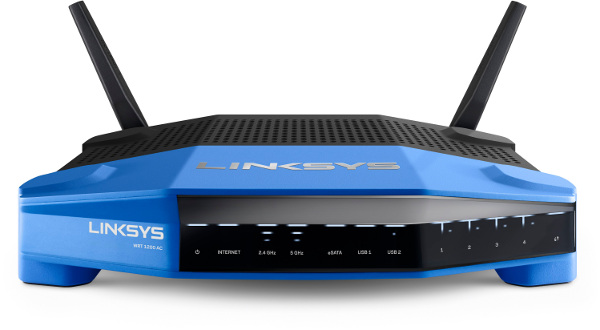Linksys Banks On WRT Nostalgia At CES With 802.11ac Router, Network Storage
At this year's CES, Linksys announced new WRT-related networking products including routers, storage products, and advances in WiFi technology that extends wireless capability and promotes mobile freedom. Producing mostly 802.11ac for this cycle, the company seems to be providing consumers with several options on speed, pricing and flexibility as adoption for this sixth generation wireless standard grows.
Last year, Linksys went back to the old school when it introduced its retro-inspired WRT1900ac wireless router. Based on the original blue/black case design of earlier WRT models (specifically the WRT54G), the WRT1900ac sports several recognizable legacy features, open source readiness, and a hint of nostalgia for its fans. Linksys said that all of the above helped make it one of the company's top-selling products. Designed as a stackable unit, up until today the only other product designed to match the Linksys WRT1900ac's physical build was the SE4008 8-port Gigabit Ethernet switch.
Now in 2015, the company is adding three new items to the WRT line.
Starting with the WRT1200ac, this new 2x2 router is a step down from the faster WRT1900AC, but at $179.99, this latest WRT family member's pricing may help bring more consumers into the world of 802.11ac. Sporting a 1.3 MHz dual-core Armada CPU, it is speed rated at 1.3 Gbps and utilizes PA + beamforming, providing a wide range of coverage. Other features include eSATA/USB 2.0 and USB 3.0 support, 4 gigabit networking ports, one gigabit WAN port and two removable -- and thus upgradeable -- antennas. Also worth mentioning is that Linksys will be making open source code for the WRT1200ac available at the new router's launch in April.
The next new member of the WRT family is the WRT Network Storage device. Stackable, like the other WRT products, the WRT Network storage device has two SATA hard drive bays and supports RAID 1 mirroring for disk redundancy. If RAID isn't used, then the storage device will show two separate drives, giving the consumer more space if the lack of data protection isn't a problem. The WRT Network Storage device also supports connectivity to eSATA and USB 3.0 drives, as well. Priced at $129.99, the new storage product will be available in spring of 2015.
Earlier, I mentioned upgradeable antennas for the WRT1200AC. Well, the third product announced at CES this week are new WRT dual-band high-gain omni-directional antennas that Linksys says can expand coverage up to 30 percent better than the stock antennas that come with the WRT1200ac and the WRT1900ac.
Tuned specifically for its WRT products, Linksys mentioned that the WRT antennas can also work with other routers thanks to their standard RP-SMA mount connectors. These new WRT antennas push 7 dBi on the 5 GHz band, and 3 dBi on the 2.4 GHz band. Available in spring of 2015, these new antennas will cost $99.99 for a set of four.
Get Tom's Hardware's best news and in-depth reviews, straight to your inbox.
Lastly, OpenWrt is getting some help from semiconductor company Marvell. The Linksys-related open source project was given WiFi drivers for pre-release testing, and Marvell released both drivers and sample images for the WRT1900ac on Christmas Eve 2014.
Follow us @tomshardware, on Facebook and on Google+.
Clarification: This article was updated at 4:30 pm ET to reflect that drivers and images have already been released for the WRT1900ac.
-
zodiacfml Reply"Sporting a 1.3 MHz dual-core Armada CPU" -- MHz? My RT-AC66U runs at 600MHz.
I also have that AC66u but the CPU seems pretty much more than enough. I tried using DD-WRT for so I can use more of that CPU and RAM but the Wi-Fi AC speeds seems to not working properly, giving me low data rates. Besides, the router really feels warm with many devices connected to it.
More powerful CPU could be useful for multiple VPN connections and Wave 2 of AC, the one with multi-user mimo. -
falchard At Tom's Hardware, you are sure to find a few typo's. Obviously its suppose to be GHz. A processor running at the speed of an Apple II on today's manufacturing process would be smaller than the solder used to mount it.Reply
To me nostalgia will not have me overcome the fact its a Belkin company. The only non-cheap crap I have gotten from Belkin was the n52te. Its cheap, but not crap.



